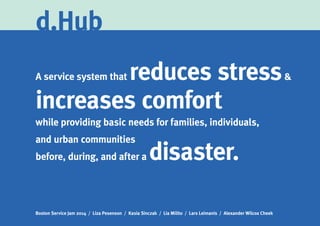d.Hub - A Disaster Recovery Service - Global Service Jam 2014
- 1. A service system that reduces stress& increases comfort while providing basic needs for families, individuals, and urban communities before, during, and after a disaster. Boston Service Jam 2014 / Liza Pesenson / Kasia Sinczak / Lia Milito / Lars Leimanis / Alexander Wilcox Cheek d.Hub
- 2. shelters / communications / services / logistics We work with existing service providers, relief organizations, and infrastructure. d.Hubs are stored in and deployed at central community locations like T-Stops, Rail and Bus Stations, Civic Centers, Post Offices, Schools, and more. After the physical spots are established, phone and tablet apps help to connect and orient people, provide updates, and help community members help each other. d.Hub
- 6. d.Hub is designed to: Be More Modular Be More Efficient Be More Orderly Be More Dignified Be Ready Be Customizable Be Potentially Long-Term
- 7. stakeholders relief organizations, federal agencies, ngos Red CrossNational Guard fema voa Army Corps of Engineers ChildrenŌĆÖs Disaster Services Salvation Army Feeding America Local Medics, Hospitals Local Shelters, Schools Pharmacists Medical Professionals Leaders Students SAFE SPOTS Hobos Individuals Families Elderly Disabled Counselors Farmers Construction Workers Volunteer Civil Services Veterinarians Water Purification Religious Groups existing services community members floods tornadoes fires hurricanes power outages communication outages healthcare needs contaminated watersanitation food displaced people panic and anxiety
- 8. louisa 55, parent, nurse Jamaica Plain Resident Working Mom, Nurse Married, Two Kids Middle Class Uses an Older Smart Phone Nursing Degree Works 50 hours a week; Worries about children (ages 12, 15); Never had outside parenting support; Extended family lives in her home country; Sleeps 5-6 hours a night. Texts with her kids a lot, mostly for ride coordination; Works with them on homework every night; Uses public transportation as much as she can; Volunteers at community health clinic in the summer.
- 9. john jane jamie 11 7 4 Dorchester Residents Siblings Live with Dad + Step Mom Large Extended Family ESL Tech Use Only at School Seen ŌĆ£FrozenŌĆØ Twice Used to having lots of responsibility; All love to dance; Picky eaters (only eat chicken nuggets); High energy, Low self-regulation. In jeopardy of repeating grades due to tardiness; All social in the community; Parents want them to all go to be first generation to attend college; Love to have fun!
- 10. drew 19, student Kendall Square Resident MIT Student PoliSci Major Upper-Middle Class from Mamaroneck, NY Wears Skinny Jeans Spends 32 Minutes on Hair Active social life and always on twitter #yolo; Binges on popular tv shows like ŌĆ£House of CardsŌĆØ; Concerned about personal image; Lives on mobile phone; Alturistic and a bit na├»ve; GPA 2.9 Needs to be connected 24/7; wears FuelBand; Makes time to hang out with friends for life balance; Seeks social validation.
- 11. deanna 40, working professional Beacon Hill Resident Partner at Big 4 Firm Recently Single Well-Educated Affluent Tech-Savvy Works 60+ hour weeks; ŌĆ£Always onŌĆØ; Control freak, neat freak; Tight social circle, but not geographically close. Needs access to news and information; knowing whatŌĆÖs going on is crucial. Uses social media as primary source of information. Keeps in sync with family, friends, colleagues. Also needs caffeine, personal space, a child-free environment, structure.
- 12. Family sees commercial for Safespot
- 13. Family receives survey in mail, opts to register with app. Mom indicates that she is a nurse.
- 14. Hurricane forecasted. App alerts parents and provides pre-storm info.
- 15. Home flooded.
- 16. Within 24 hours app notifies parents that Safespot is present at local T. Prompts to check in. Family checks in and says they need shelter. Also confirm that uncle has already checked in with a hub across the city.
- 17. Family arrives at Safespot hub. App alerts them that shelter is ready and directs them to finds color coded shelter wall.
- 26. Mother gets notification that her medical services are needed and provides medical service.
- 27. Family checks out by scanning code on their shelter.
- 31. artifacts people + agencies logistics people information artifacts, touchpoints, services pre-pre- disaster d.Hub Packs Deployed + Stored, Census Safespot Disaster-Specific Modules Red Cross, Army Corps of Engineers, Mobile Carriers, Medical Groups Red Cross, Army Corps of Engineers, Mobile Carriers, Medical Groups, Volunteer Relief Workers Red Cross, Army Corps of Engineers, Mobile Carriers, Medical Groups, Volunteer Relief Workers Community Volunteers Doctors, Pharmacists, Construction Workers, Therapists, Sign-in; Skills Board; Needs List Storm-Specific Instructions; Safespot Sites Census and Registration of Community Resources Shelter-in-Place or Move to Existing Community Shelters Deployment Individual and Family Preparation Personal Needs and SuppliesPacks stored locally; Others storied at regional deployment spots Gathering & Organizing Supplies Early Coordinating Groups Deploying Artifacts Specific to Anticipated Disaster, if appropriate Coordinating Groups Setting up Central Hub; Establish Power, Communications; People Coordination; Supplies Distribution Central Hub Providing Food, Shelter, Clothing, Communications, Power Grid, Medical Services, Mental Health Services, ChildrenŌĆÖs Needs Skilled Workers Medical Supplies; Food and Clothing Crowd-Sourced Updates, Maps; Skills Boards; WhoŌĆÖs Where? d.Hub Community Hub; d.Hub Modules pre- disaster disaster strikes immediately after the days that follow backstage frontstage Ad Campaign Redefining Preparedness for Community Members; Orients Them to d.Hub Boston Service Jam 2014 / Liza Pesenson / Kasia Sinczak / Lia Milito / Lars Leimanis / Alexander Wilcox Cheek
- 44. Boston Service Jam 2014 / Liza Pesenson / Kasia Sinczak / Lia Milito / Lars Leimanis / Alexander Wilcox Cheek d.Hub












































